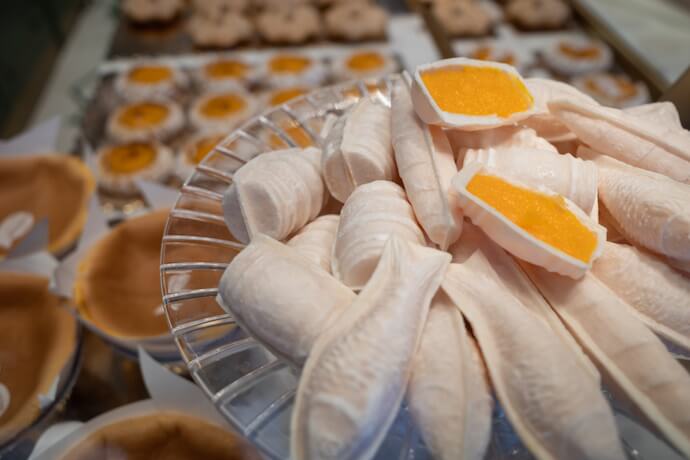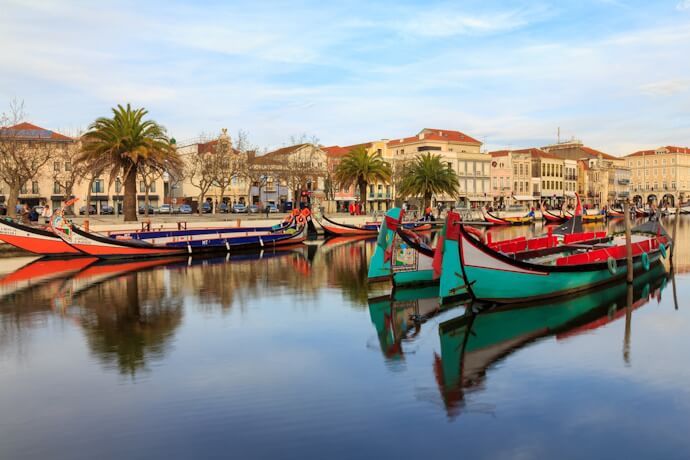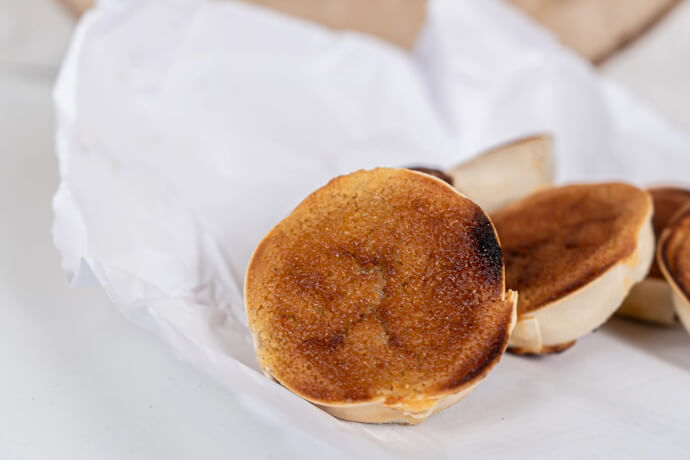Welcome to the delectable world of Portuguese sweets, a realm where every bite tells a story of mouthwatering regional flavours! Portugal offers an array of desserts that are as diverse and appealing as its landscapes. From the charming streets of Lisbon to the lush hills of Madeira, each region has its own unique sweet treat, infused with local ingredients and centuries-old techniques.
Here, we embark on a sweet journey across Portugal, exploring 10 must-try desserts that are more than just confections – they are cultural treasures. Prepare to have your culinary curiosity piqued as we delve into the sweet essence of Portugal!
Ovos moles, Aveiro
These unique sweets, encapsulated in delicate wafer shaped like seashells or fish, pay homage to Aveiro’s close ties with the sea. And how is this mouthwatering sweet made? The yolks are mixed with sugar and then slowly cooked until they form a smooth, sweet paste. This paste is then traditionally enclosed in a very thin, wafer-like pastry made from wheat flour. It's a true taste of Portuguese history!
These delicious sweets were first made by nuns in the convents of Aveiro. The nuns used large quantities of egg whites for starching their clothes and, not wanting to waste the yolks, began using them to make desserts, leading to the creation of Ovos Moles. These have even been granted Protected Designation of Origin (PDO) status by the European Union which recognizes the traditional production method.
Ovos Moles are a centrepiece in local festivals and celebrations, and they play a significant role in Aveiro’s tourism and gastronomy. They offer a unique glimpse into the regional flavours and cultural heritage of Aveiro, making them a must-try for anyone visiting Portugal!
Known as the "Venice of Portugal", Aveiro is a charming city with picturesque canals, colourful boats called 'moliceiros', and Art Nouveau architecture. With its stunning beaches, like Costa Nova with its candy-striped houses, and its lagoon, Ria de Aveiro, this city, close to Porto, is one of the perfect Portuguese destinations for your next vacation!
Queijadas and Travesseiros, Sintra
Picture a small, cheesy, sweet delight. That is a Queijada for you! Originating from the picturesque town of Sintra, these little cakes blend cheese, sugar, eggs and flour into a bite-sized marvel. The exact origins of Queijadas are a bit hazy, but they are believed to have been made in this quaint village since at least the 13th century. Traditionally, Queijadas are small, round cakes made from a mixture of cheese, sugar, eggs and flour. They have a unique texture that is slightly crispy on the outside and deliciously creamy inside, offering a delightful blend of sweet and tangy flavours. Originally made by nuns in convents, Queijadas were a way to use up leftover cheese and other ingredients.
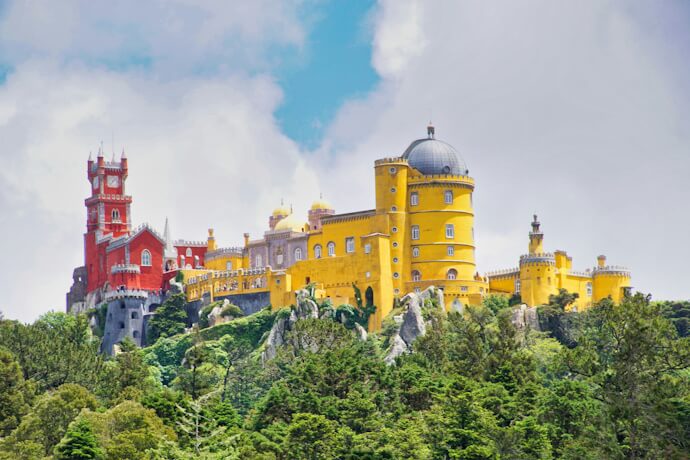
Stuffed with a sweet almond and egg yolk filling encapsulated in a puff pastry shell, the Travesseiros are a blend of textures and tastes. The Travesseiro, meaning 'pillow' in Portuguese, owes its creation to Casa Piriquita, a famous bakery in Sintra, which began making them in the 1940s. These have quickly become an integral part of Sintra's gastronomy and tourism. Typically, they are dusted with powdered sugar and best enjoyed warm, often accompanied by coffee.
Sintra, a fairytale town near Lisbon, is renowned for its lush hills, mystical palaces and romantic 19th-century architecture. From its iconic Pena Palace perched atop a verdant hilltop to the mysterious Quinta da Regaleira with its mystical gardens and underground passages, this UNESCO World Heritage site invites exploration and sparks the imagination!
Pastel de Belém, Lisbon
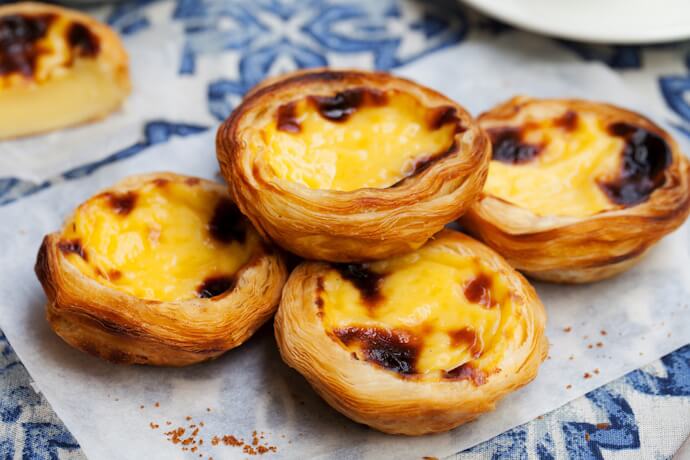
The Pastel de Belém, also known as the Pastel de Nata when made outside of its original bakery, is an iconic Portuguese pastry that has become synonymous with Lisbon's culinary identity. It originated in the Jerónimos Monastery in the parish of Belém, Lisbon, in the early 19th century.
Around 1834, when all Portuguese convents and monasteries were shut down, the monks from Jerónimos started selling these pastries at a nearby sugar refinery to generate revenue. This led to the creation of the Fábrica de Pastéis de Belém in 1837, which continues to make these delicacies using the monks' original secret recipe.

From what we know, it is made from puff pastry filled with a custard made from milk, sugar, flour, lemon zest, and egg yolks. They are baked at a high temperature to create a flaky crust. Typically, they are best enjoyed warm, sprinkled with powdered sugar and cinnamon.
Belém, a picturesque Lisbon suburb, is steeped in maritime history and renowned for its monumental sites like the Jerónimos Monastery and Belém Tower. It offers a rich cultural experience with its museums, lush gardens, and riverside promenades.
Bolo de Mel, Madeira
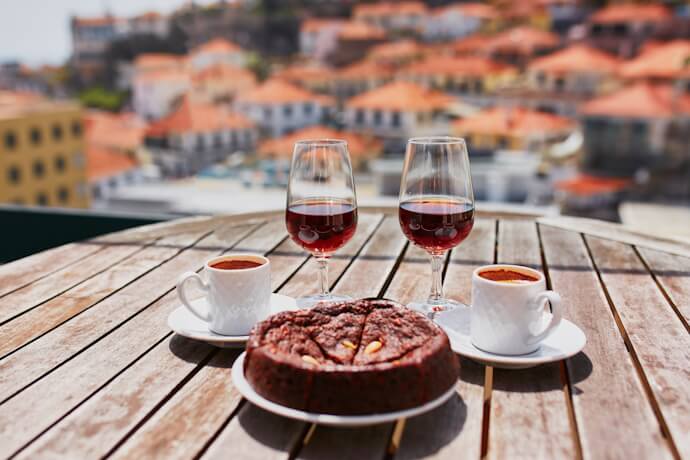
Bolo de Mel, which translates to "Honey Cake", is a traditional Madeiran delicacy with a unique flavour profile. It is believed to be the oldest sweet from Madeira, with its origins tracing back over 500 years. Historically, it’s connected to the celebration of the Christmas. However, its popularity has made it a year-round treat!
As the name suggests, the primary ingredient is molasses or sugarcane honey, which gives its distinctive dark colour and rich flavour. It includes a mixture of spices like cinnamon, cloves, and sometimes anise, along with dried fruits and nuts. The cake is dense and rich.
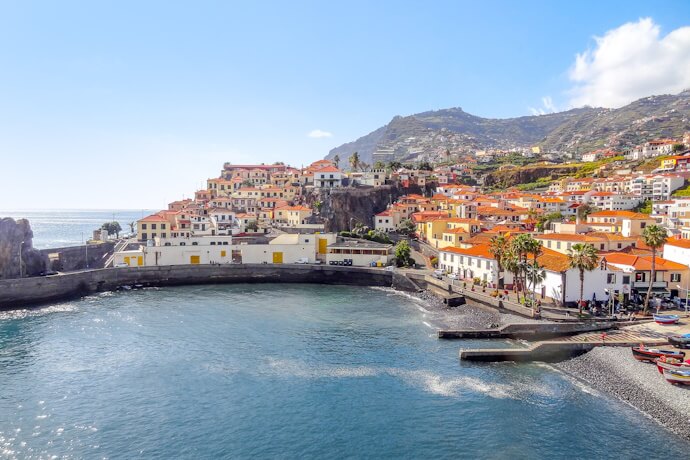
One of the notable features of Bolo de Mel is its long shelf life. It matures and develops its flavours over time. Often enjoyed with a glass of Madeira wine, it offers a harmonious blend of the island’s culinary delights.
Madeira, which is a Portuguese archipelago, is also known for its rugged landscape, lush gardens, and wine. This volcanic island boasts a mild climate, dramatic cliffs, and pebbled beaches, making it a popular destination for nature lovers and adventure seekers.
Torta de Azeitão, Arrábida
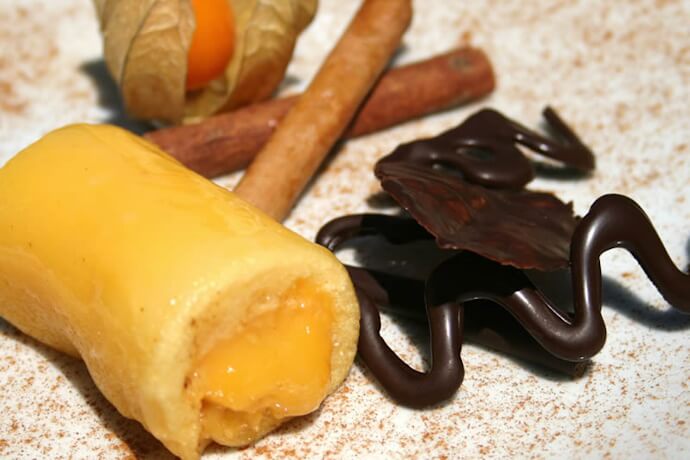
The tasty Torta de Azeitão is a traditional Portuguese pastry that originates from the small town of Azeitão, nestled in the picturesque Arrábida region. The origins of this delicious sweet date back to the 19th century. It was initially crafted by local convents and has since become a regional speciality.
The primary ingredients are eggs, sugar, and cinnamon, but some recipes also include almond extract or lemon zest to add depth to the flavour. The torta is essentially a thin, rolled sponge cake filled with a soft egg-based cream. It's known for its delicate, moist texture and rich, sweet taste. Today, Torta de Azeitão is a beloved treat in Portugal and is often paired with local wines from the Setúbal region.
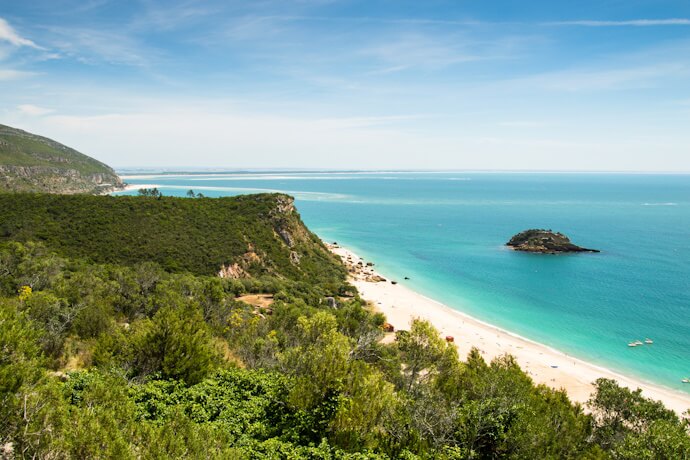
Azeitão, in the serene Arrábida area, is a charming village famed for its fine wines and traditional cheeses. Arrábida, a picturesque natural park, is known for its breathtaking mountainous landscapes, pristine beaches, and diverse flora and fauna. This tranquil oasis near Lisbon offers stunning views, hiking trails, and a serene escape into nature's embrace.
Sericaia, Alentejo

Sericaia, also known as Sericá, is a traditional Portuguese dessert originating from the Alentejo region in southern Portugal. The dessert is believed to have been introduced by the Portuguese during the Age of Discoveries, influenced by the spices they brought from the East. Its primary ingredients are eggs, sugar, flour and milk. The key spice, however, is cinnamon, which is used generously. Sericaia is known for its unique fluffy texture, almost like a cross between a cake and a pudding.
Today, Sericaia remains a popular dessert in Portuguese cuisine, often served in restaurants and homes across the country. It is traditionally served with a side of 'ameixa de Elvas' – plums that are cooked and preserved in syrup. Visitors to Alentejo often seek out Sericaia as a quintessential taste of the region.
.jpg?width=690&height=460&name=Elvas%202%20(2).jpg)
Elvas, a UNESCO World Heritage city in Alentejo, stands out for its well-preserved fortifications, including star-shaped walls and forts, which offer a glimpse into the strategic importance of Elvas throughout the centuries, evoking a sense of awe and reverence.
While meandering through its narrow cobblestone streets, you will also discover a tapestry of architectural styles, from medieval churches to elegant Renaissance palaces. And amidst its historical grandeur, Elvas delights the palate with its culinary delights, especially sweet treats crafted from the region's famed plums. In Elvas, military history, culture and gastronomy intertwine to create a lasting impression!
Queijadas de Vila Franca, São Miguel
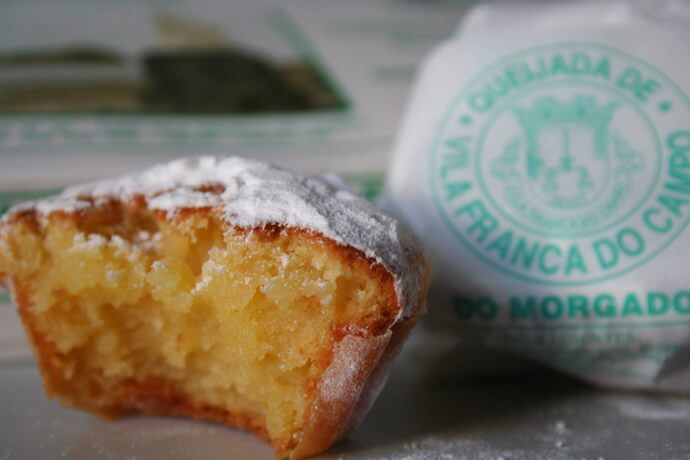
Queijadas de Vila Franca are a traditional Portuguese pastry originating from the town of Vila Franca do Campo, on São Miguel Island in the Azores. These small, sweet cakes are a delightful part of the Azorean culinary landscape!
The recipe is steeped in history and was traditionally made by nuns in convents. These queijadas are primarily made with eggs, sugar, and cheese or curd. They have a unique texture that's slightly crispy on the outside while remaining soft and sweet on the inside. The flavour is a perfect balance of sweet and tangy, making them perfect for a light snack or dessert.
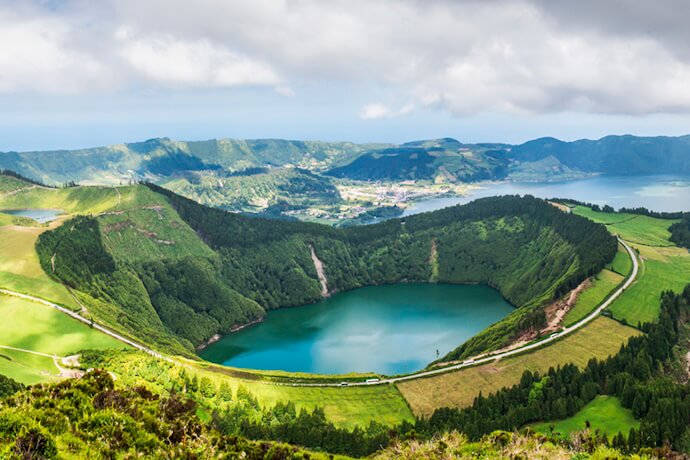
Queijadas de Vila Franca remain popular in the Azores and among the Portuguese diaspora. They have become synonymous with São Miguel’s culinary identity. While the traditional recipe is still widely used, some modern interpretations might add flavours like vanilla or lemon zest.
Vila Franca do Campo, once the capital of São Miguel, is a picturesque town known for its historic charm and stunning seaside views. São Miguel, the largest island of the Azores, dazzles with its lush, volcanic landscapes, including the breath-taking Sete Cidades and Furnas.
Doce fino, Algarve

These delicacies are much more than desserts; they are edible pieces of art! Originating from the Algarve, the southernmost region of Portugal, known for its beautiful beaches, Doces Finos are believed to have Arab roots and to have evolved from traditional convent sweets. They have become a customary treat in the Algarve, a region known for its significant almond production.
The primary ingredient is almond paste, made from ground almonds and sugar. What sets Doces Finos apart is their intricate and artistic design. They are meticulously shaped and painted to resemble various objects, like fruits, vegetables, flowers and animals. They are equally delightful in taste – sweet, with a rich almond flavour. Their unique appearance and delicious taste make them a sought-after souvenir!
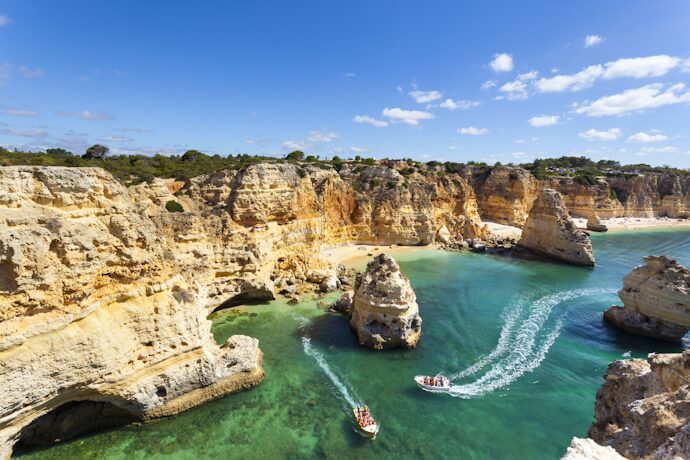
The Algarve, Portugal's southernmost region, is famed for its stunning coastline, golden beaches and picturesque cliffs. It's a sun-kissed paradise offering vibrant towns, rich history, delicious seafood, and world-class golf courses, making it a top European holiday destination.
Pastel de Tentúgal, Coimbra (and around)

Pastel de Tentúgal is a traditional Portuguese pastry, originating from the small town of Tentúgal, near Coimbra. The recipe dates back to the 16th century and is attributed to the Carmelite nuns of the Tentúgal Convent. It reflects the historical tradition of conventual sweets in Portugal.
The primary ingredients are egg yolks, sugar, and flour, and the pastry is notable for its extremely thin and crispy dough, enveloping a rich, sweet egg yolk-based cream. The fine layers of dough are carefully prepared and folded, then filled with the sweet cream and baked until golden. Pastel de Tentúgal is often seen in bakeries and cafes, especially in the Coimbra region.

Coimbra, a riverfront city in central Portugal, is renowned for its historic university, one of the oldest in Europe, creating a vibrant academic atmosphere. It's rich in medieval architecture, traditional Fado music, and picturesque cobbled streets, offering a blend of history, culture, and beauty.
Pudim Abade de Priscos, Braga
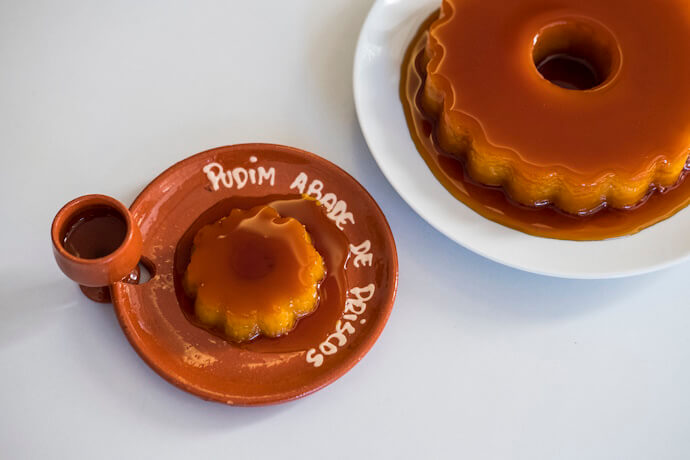
Pudim Abade de Priscos, originating from Braga, is a distinctive and luxurious Portuguese dessert. The recipe was developed in the 1800s by a Portuguese priest, Abade de Priscos. The Abade (abbot) was known for his culinary skills and contributed significantly to Portuguese gastronomy, with this pudding being his most famous creation.
Surprisingly, one of the key ingredients is a small amount of pork fat, which gives the pudding its distinctive texture and flavour. It also includes egg yolks, sugar, and caramel, with some recipes calling for Port wine or lemon zest for added flavour. The result is a rich, creamy, and smooth pudding with a unique depth of flavour, set under a layer of sweet caramel. Pudim Abade de Priscos remains a cherished dessert in Portugal, especially in Braga, where it is a symbol of the city's culinary heritage.
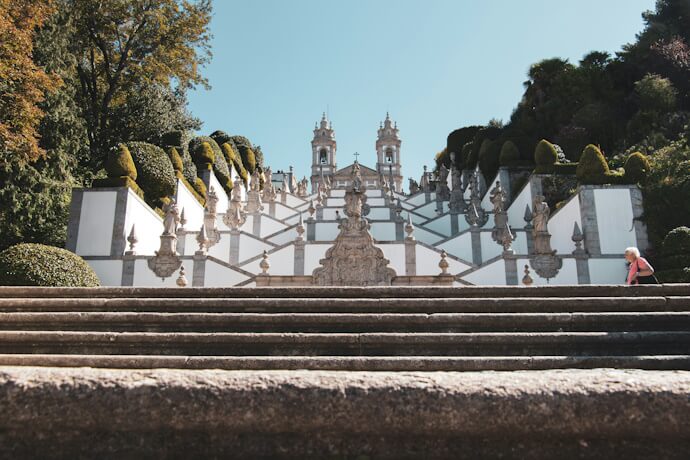
Braga, one of Portugal's oldest cities, is known for its deep religious heritage, baroque churches, and the stunning Bom Jesus do Monte sanctuary. Rich in history and tradition, it’s characterized by its ancient streets with a youthful energy, thanks to a vibrant university population, making it a dynamic cultural hub.
Is your mouth watering already?
This journey through the delightful world of Portuguese sweets reveals much more than just the flavours of Portugal – it also unveils its heart and soul. From the creamy, egg-yolk richness of Pastel de Belém in Lisbon to the artistic almond delights of Doces Finos in Algarve, each sweet is characterized by its regional uniqueness. These 10 desserts are edible windows into the diverse and vibrant spirit of Portugal! So, next time you visit, remember to explore and taste these iconic sweets – each a bite of tradition, each a memory to cherish.


